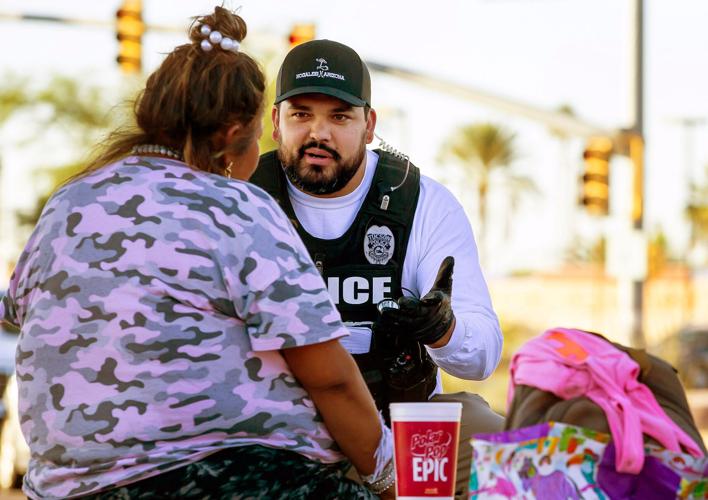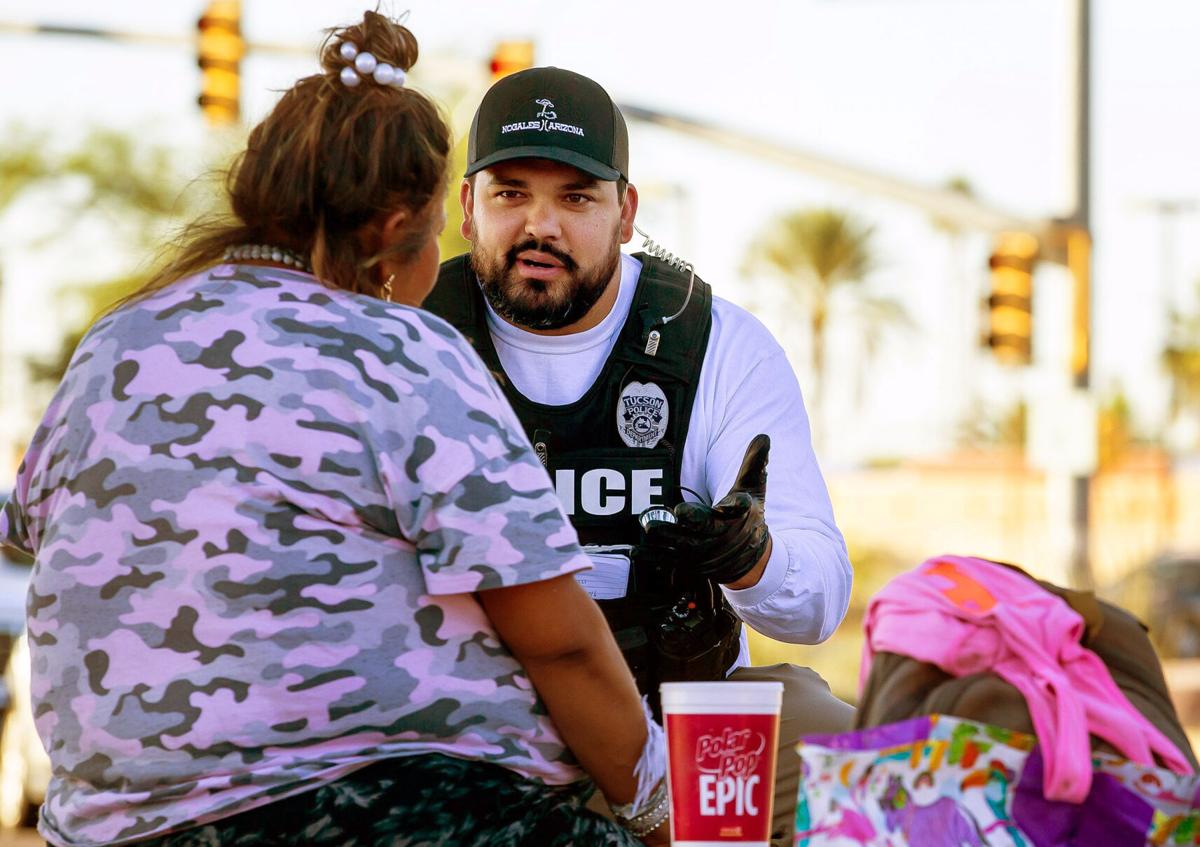On a Thursday evening in late August, six people identified as drug dealers by Tucson police arrived at the west-side substation after receiving an unusual invitation from Assistant Chief Kevin Hall.
The invitation was intriguing: After an "extensive undercover campaign," the person had been identified as a street-level drug dealer. He or she was invited to a meeting in which they would not be arrested. They would be shown evidence police had gathered against them, while also being given the option to stop dealing. The letter said more than once: "This is not a trick."
The invitees, all from the 85705 ZIP code area, were taken to a conference room and pointed to tables in the center, surrounded on three sides by police officers and community members seated around the room's perimeter.
"You are here tonight because you are part of the Tucson Police Department Drug Market Intervention," Lt. Lauren Pettey told them. "For the past year, Tucson Police Department has been conducting an undercover operation in the '05 community, and as you will see later, we have evidence that each of you has sold drugs to undercover officers."
It was the first time Tucson police have used this strategy, one of several new tools being used in Pima County to combat the record-high overdose deaths expected for 2021, which officials are calling a community problem that can't be arrested away.
Pettey warned the invitees that TPD would "not tolerate drug dealing or violence in this neighborhood anymore," but that they were there that night surrounded by service providers, faith-based organizations, police and neighbors, because they were being given a chance.
"To make positive choices and turn your life around," Pettey said. "And we are going to support you if you make the right choices."
She pointed at a white board at the front of the room with a series of nine mug shots, all of neighborhood drug dealers with prior convictions or a history of violence who had been arrested and recently sentenced. Pettey told the six invitees — none identified as violent offenders — they'd be facing a similar outcome if they didn't make the right choice.

A syringe, straw and small piece of aluminum foil commonly used for narcotics such as counterfeit opioid pills called "Blues" are placed on the ground after Tucson police Officer Michael Cuestas confiscated them at Grant and Oracle roads.
"We care about you and we are concerned about you. But understand this: Continued involvement in drugs and crime will result in negative consequences," she said. "You will not get this opportunity again. I urge you and encourage you to make a good choice."
The chief of the Pima County Attorney Office's Narcotics Bureau spoke after Pettey, telling the attendees about the strength of the case built against them, which could result in up to 10 years in prison.
TPD Detective Crystal Farley set each person's case file down in front of them and opened it. On the left side was a felony complaint listing charges and probable cause, filled out and ready to be filed in court. On the right side was the case file with photos and all the other evidence collected.
They were again presented with the choice to walk away from that life. If they didn't take it, Pettey said, the next time they were caught selling they would be arrested on the new charge as well as all the charges already in the case file.
Community members in attendance, including several local business owners, spoke about the impact of drug use and crime on their staffs, customers and livelihoods. Peer specialists from CODAC health and wellness were also on hand to talk to attendees privately about substance use treatment, which was offered to all attendees, along with education, job training, transportation assistance, mentoring and help with family issues.
At the end of the session, each invited attendee was given an acknowledgment form and the choice to sign. The form said he or she had reviewed the information about potential criminal charges levied against them, had been given the opportunity to ask questions about the case, and now had the chance to make a positive change.
"I understand that services will be provided to assist me in becoming a productive and influential member of the community. I plan to take advantage of this opportunity to become engaged with services to improve my life."
All six signed the forms.
And then they stuck around, laughing and chatting with the officers.

Six people found to be responsible for high-volume drug sales were invited to this Drug Market Intervention session at a Police Department substation. They were offered the opportunity to stop selling immediately and walk away from the trade (with assistance in finding a job, housing and treatment) or face immediate charges the next time they're caught.
Two months later, all six attendees have complied with that nonbinding agreement and none has been arrested.
Pettey said she's pleased with the short-term response, as were neighbors and area business owners, who reported an immediate effect.
The Drug Market Intervention strategy is sanctioned by the U.S. Bureau of Justice Affairs, has been employed in numerous other cities, and has been shown to be effective in reducing drug sales and violent crime and returning a neighborhood to the residents.
Cost savings,
less violence
The strategy is a focused deterrence approach to eliminate an open-air drug market — a geographically defined area identified as a hot spot for drug sales — in a small area.
For years, parking lots, street corners and washes have been sites of drug sales in 85705, an area popular with dealers, police say.
The intervention strategy eliminates the market, according to researchers at Michigan State University, who developed the program. They say it also removes chaos and violence, resets community norms while enhancing safety, and strengthens partnerships between law enforcement and the community.
Drug Market Interventions, or DMIs, first saw success in High Point, North Carolina, in 2004 and in the years since, 40 other locations have used the model, including Rockford, Illinois; Damascus Gardens, Maryland; Nashville; Seattle; and Atlanta.

Two years after High Point's initial DMI, the city was seeing a 20% reduction in violent crime citywide. In the neighborhoods in which the intervention was employed, a 57% reduction of violent crime was sustained over six years. That reduction equates to millions of dollars saved by the city, according to Michigan State University research.
Atlanta has seen a nearly 40% decrease in violent and drug crimes since its first DMI in 2015.
Researchers have found no evidence that the open-air markets are displaced to other areas, saying that when residents are able to reclaim their neighborhoods following the intervention, the dynamic changes.
Tucson's Drug Market Intervention is part of the bigger Thrive in the ’05 Community-Based Crime Reduction Initiative, which targets a 2.6-square-mile area that’s loosely bounded by Miracle Mile to the north, Speedway to the south, Stone Avenue to the east and I-10 to the west. The program is overseen by Arizona State University's Office of Community Health, Engagement and Resiliency.
An important part of the DMI is making services available to the dealers who are the candidates for intervention, which is why TPD brought in Arizona Complete Health, the Regional Behavioral Health Authority, to ensure treatment options would be provided.
"Now that TPD has reached out and has been working with AZ Complete Health and really brought in that piece of it, in my mind, that brings in that sustainability," said Nadia Roubicek, Thrive in the 05 program manager.

Pima County is on track to exceed 500 overdose deaths in 2021, setting a new record.
The August "call-in" event, the name organizers use for it, was initially supposed to take place in 2020, but like most things planned for last year, the pandemic got in the way.
Initially there were some people who probably thought the dealers shouldn't be getting a second chance, as they worried they would keep selling, Pettey said. But she said they were able to see the goal and the validity of the program. By the time the call-in occurred, community engagement was strong.
"A lot of our community partners were really excited to be a part of this," Roubicek said. "We had lot of different folks, a lot of involvement, a lot of desire to be involved."
Arrests solve
only so much
Drug Market Interventions are a nine-step process that doesn't end after the dealers have signed their contracts.
The call-in is the culmination of previous steps, which include crime mapping, undercover operations and mobilizing community commitment. What happens next is just as important, said Roubicek.

After noticing narcotics possesssion, Tucson police Officers Michael Cuestas and Harrison Still wait for two people to come out from behind a dumpster at Grant and Oracle roads.
Neighbors will now report to police if they find out that the second-chance dealers resume selling, and police will quickly respond. With officers still doing crime mapping to identify any new sellers who might pop up to take over the business, police will be able to quickly quash those efforts, Pettey said.
"It's here in Tucson that I have gained respect for the Police Department. I see how much (they) do for us and it makes me want to continue the effort," Donna Perry, a resident of the Coronado Heights Neighborhood, said in a text message to Pettey after the call-in.
The last two steps — enforcement and follow-up — are underway. TPD has arrested the three people who did not accept their invitations to the call-in, after they received notification that they'd been arrested for selling again.
There's a strong set of checks and balances in place to make sure the DMI candidates will be successful, including auto-alerts of any new arrests, Pettey said.
Asked about the possibility of a worst-case scenario, such as an overdose resulting from a dealer still selling while out on a second chance, Pettey said:
"If we had concerns and didn't think they'd be eligible to be successful, they wouldn't be getting a second chance. When someone gets out of prison, they theoretically get a second chance, but sometimes they go out and commit another crime. These people were chosen based on special criteria."
TPD hopes that if this pilot DMI succeeds, police will be able to use the strategy in parts of the city where generational dealing is occurring, said Lt. Frank Hand.
"I've been doing this job for decades. We are not going to arrest our way out of this problem," Hand said.
Prevention and
treatment are key
The Southern Arizona Counternarcotics Alliance is seizing pills in such large quantities, it doesn't even bother counting them anymore, and instead just weighs them, said Capt. John Leavitt.
"We can create penalties for engaging in the behavior of trafficking or selling, but prevention and treatment is the long-term solution," Leavitt said.
Destigmatizing substance use so that it's viewed as a public health issue is also key, Leavitt said.
TPD and Pima County health officials are concerned about the rising use of opioids among young people in the 20- to 40-year age groups, and also among teenagers.
Pima County saw a record-high 446 overdose deaths in 2020, and experts say 2021 is on track to be even deadlier.
As of Oct. 25, Pima County has recorded 377 fatal overdoses, but that number is misleading, said TPD Assistant Chief Kevin Hall. "This number runs behind by four to six weeks due to the time it takes to get the toxicology analysis back from an autopsy," Hall said.
Hall said that at this rate, Pima County will finish out the year with more than 500 overdose deaths, nearly twice the total from five years ago.
TPD's Community Response Team for the 85705 area continues to target the active drug market, building future DMI cases through undercover work.
Officers also continue to administer opioid-reversing medication called naloxone when necessary, and have administered 79 doses to date. The department's Substance Use Resource Team has also been distributing naloxone to at-risk individuals and their families, with 435 kits given out as of early this week.
While the short-term effects of this evidence-based, community-based DMI have been positive, Hand, Pettey and others hope the project sees similar results as other venues.
"It's sometimes hard with these types of projects to see what is going to be the true effect of it," Pettey said.
Roubicek said initiatives like this are important because they put humans front and center and address the root causes of problems, instead of just putting a band-aid on a wound.
"In this 'Thrive' area, it's some of the police officers who have been most consistent and caring in showing up for these people over the years," she added.
The Southern Arizona Crisis Intervention Team trainings are aimed at teaching Tucson-area first responders how get people in crises necessary help instead of taking them to jail.
To read the full story, click here.










